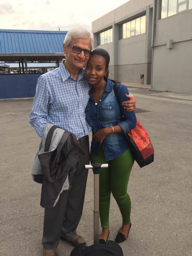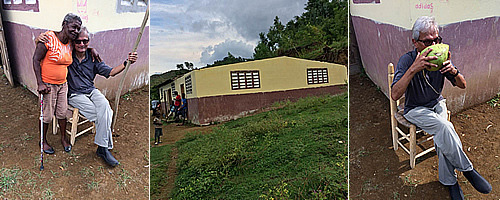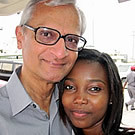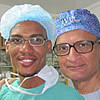
This was my fourth trip to Haiti. It seems like I have to wait for disasters and mayhems to happen to rush back to the embrace of my beloved Haiti.
This time it was the Hurricane Matthew that wreaked havoc to Haiti in general and to my school in Leogane in particular. My Haitian daughter, Thamara, wrote:
“Dad, things are bad all around, but we are fine, please do not worry”.
I could not sit idle and had to go assess the damage and plan reconstruction.
My Haitian American friend Jensen joined me. After a red eye flight to Miami, I took the noon flight to Port Au Prince (PAP). Lack of sleep was taking its toll on me, but I was cheered up by the Thammie’s embrace at the gate. Jensen and I checked in the Best Western where another young man, Clarence, joined us.
Thammie came along with Dmitri, whom I met 5 years ago during our medical camp. I listened to Thammie’s chatter about her family, her job and her recent encounter with rogues that robbed her family savings and her laptop. I told Dmitri to find a place in a safer neighborhood for Thammie’s family to move. Thammie insisted on my taking a nap. They all went to Jensen’s room while I showered and rested for about an hour.
We all then went to a nice restaurant. Jensen and I had a Caipirinha. Jensen made me order a Haitian dish with Conch meat, which I didn’t fancy much. The restaurant band played beautiful Caribbean music including my request of Guantanamera.

We were all happy to be together once again in Haiti. I recalled my last blog entry on Haiti…
Haiti envelops me, embraces me, engulfs me in her unconditional love. And so little I can give back in return.
Dmitri drove Thammie back to her home and we returned to our cozy hotel.
Next day, after breakfast Jensen and I with our driver James went to Leogane. After about an hour we started climbing up through the forest towards the mountains. The wreckage from the hurricane was all around us. We came to a shallow river which James drove through slowly.

We were all worried about hitting a boulder under water and getting stuck. I got out and put on my wading boots, we carefully walked through the river to the bank where we found horses waiting for us. I climbed up on one of the horses and started trotting towards the mountain. It was an arduous journey for about two miles until we reached the top.

My feelings were bitter sweet finding the school still standing but half the roof and solar panels had been blown away. The children surrounded me and the 86 year old grandmother was happy with my assurance about repairing the roof of the school. The doors and windows facing the blast of the hurricane were also broken. The community leader and teacher Jonas showed us around and we discussed our plans on repairs to be done.

I was extremely tired, but rejuvenated with coconut water. We came down the mountain again on horseback to our car by the river. The village children waved farewell to us. Jensen said that Thammie called and rebuked him for taking me all the way and I said that if I had known it was going to be so hard I may not have come but I am glad that I did make the journey. We drove back to PAP where Thammie and Dmitri were to join us for dinner, but it started raining and I told Thammie not to come in the rain.
Next day after breakfast I took a stroll in the city on foot. Our car had sustained damage to the brakes, so James took it for repair. I rested in the afternoon watching US election fever on CNN. In the evening Thammie came to visit after work. We had a long chat about her work, finances and her future. She was visibly enchanted by my visit.
We went for dinner at a nearby hotel. Jensen’s Facebook friend Abbey joined us. Jensen made a touching farewell speech thanking me for coming back again and again to stand by and help them. I thanked them for their accommodation and acceptance and giving me the opportunity to serve Haiti.

My flight was early the next morning, I said goodbye to Thammie. Her eyes welled up as she hugged and said,
“Thanks, Dad.”
I know I left my heart in Haiti and I will always have a place in the Haitian heart to come back to.
Now I have to raise awareness and gather funds to repair and expand the school in Leogane.
I shall not give up on those beautiful as well as resilient children of Haiti.
Haiti 101, a brief history of Haiti
As one of the poorest countries of the world Haiti bears the historic scars of economic and political exploitation by the western powers from its inception as the first black sovereign state.
In 1492, with the expedition of Columbus, the island of Hispaniola was colonized by Spain. In quarter of a century the natives were almost completely eliminated and repopulated by slaves from Africa. In 1697 Spain ceded one part of the island to France that became Haiti and kept the part that became the Dominican Republic. Sugar industries and forestry soared but none went for the local population of the slaves. In 1791 the slaves rebelled against the French and in 1804 declared independence driving away the French. The rebellion became the only slave uprising in history with the foundation of a new country of Haiti.
Unfortunately and sadly for reasons inexplicable to many, in 1825 the new Haitian government agreed to pay France 150 million francs to compensate them for their losses from the uprising and even though defeated, France would recognize the independent nation. As bizarre and unfair it may sound, Haiti continued to pay around 80% of its national revenue until the entire amount was paid off in 1947. By then Haiti became an economically fragile nation.
The US as well as other European countries were eyeing Haiti for a potential naval base in the Caribbean since mis-1800. In 1915, the US invaded claiming to be there as a stabilizing force to ease civil unrest as a parental figure. But its actions revealed the underbelly os self interest. One of its first moves was shifting Haiti’s financial reserves to the US and rewriting the constitution to give foreigners land rights on the island. Haitian writer Edwidge Dandicat notes – During the 19 years of the US occupation, 15 thousand Haitians were killed. Any resistance to the US-installed puppet regime was crushed and a gendarmerie modeled after an occupation force was created. Although US troops officially pulled out in 1934, the US exerted control over Haiti’s finances until 1947. Many argue that American intervention in Haiti still has not ended.
This unstable financial mayhem led to political turmoil. From 1957 to 1986 Haiti was ruled by two terrifying corrupt dictators: Francois ‘Papa Doc’ and Jen Claude ‘Baby Doc’ Duvalier. Both the father and the son employed armed militia to silent dissenters and stole millions of dollars from local and foreign sources as country’s loans that amounted to about 40% of the country reserve. About 30 thousand Haitians were killed and all major social institutions were crushed or infiltrated during their regime.
Since then Haiti has been controlled by various military dictatorship and democratically elected governments. Years of brutality and oppression have scarred the political system, and Haiti is still trying to find its way as a democratic nation.
 As I slowly tugged my suitcase through the airport, I heard the happy tinkling of laughter calling my name. It was my Haitian daughter Tamara, she embraced me in her arms. We chatted about her academic performance as she had just finished her second semester at the
As I slowly tugged my suitcase through the airport, I heard the happy tinkling of laughter calling my name. It was my Haitian daughter Tamara, she embraced me in her arms. We chatted about her academic performance as she had just finished her second semester at the 



